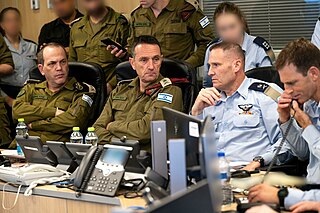Al-Asad Airbase is an Iraqi airbase located in al-Anbar Governorate of western Iraq. It was originally known as Qadisiyah Airbase.

Since the Iranian Revolution in 1979, the Islamic Republic of Iran has been embroiled in tense relations with the U.S. and its allies. Following the hostage crisis, both countries severed relations. Since then, both countries have been involved in numerous direct confrontations, diplomatic incidents, and proxy wars throughout the Middle East, which has caused the tense nature of the relationship between the two to be called an 'international crisis'. Both countries have often accused each other of breaking international law on several occasions. The U.S. has often accused Iran of sponsoring terrorism and of illegally maintaining a nuclear program, as well as using strong rhetoric against Israel, of which Iran has questioned its legitimacy and its right to exist while supporting Hamas, an antizionist terrorist group in the Gaza Strip. Meanwhile, Iran has often accused the U.S. of human rights violations and of meddling in their affairs, especially within the Iranian Democracy Movement.

Kata'ib Hezbollah, also known as the Hezbollah Brigades, is a radical Iraqi Shiite paramilitary group which is a part of the Iraqi Popular Mobilization Forces (PMF), staffing the 45th, 46th, and 47th Brigades. During the Iraq War (2003–11), the group fought against Coalition forces. It has been active in the War in Iraq (2013–2017) and the Syrian Civil War. The group was commanded by Abu Mahdi al-Muhandis until he was killed in a US drone attack in 2020. Thereafter, Abdul Aziz al-Muhammadawi became the new leader of the PMF. The group seeks to establish an Iran-aligned government in Iraq, expel American forces from the country, and advance the regional and international interests of Iran in Iraq and the region. The group is responsible for killing hundreds of U.S. soldiers and takes a central part in carrying out attacks against U.S. targets in Iraq and acts as part of the Axis of Resistance. Kata'ib Hezbollah has received extensive training, funding, logistic support, weapons, and intelligence from the IRGC's elite Quds Force.

Rocket attacks on the neighboring cities of Eilat, in Israel, and Aqaba, in Jordan, have been a tactic used by militants from the Palestinian Islamist group Hamas and organizations linked with Al-Qaeda because of the relative ease of launching rocket attacks against these two cities from adjacent desert areas. Most of these attacks target Eilat, the last attack on Aqaba was in 2010.

The History of the Israel Air Force begins in May 1948, shortly after the formation of the State of Israel. Following Israel's declaration of independence on May 14, its pre-state national institutions transformed into the agencies of a state, and on May 26, 1948, the Israeli Air Force was formed. Beginning with a small collection of light aircraft, the force soon transformed into a comprehensive fighting force. It has since participated in several wars and numerous engagements, becoming what has been described as "The mightiest air force in the Middle East".
The Axis of Resistance is an informal Iranian-led political and military coalition in West Asia and North Africa.

The Iran–Israel proxy conflict, also known as the Iran–Israel proxy war or Iran–Israel Cold War, is an ongoing proxy conflict between Iran and Israel. In the Israeli–Lebanese conflict, Iran has supported Lebanese Shia militias, most notably Hezbollah. In the Israeli-Palestinian conflict, Iran has backed Palestinian groups such as Hamas. Israel has supported Iranian rebels, such as the People's Mujahedin of Iran, conducted airstrikes against Iranian allies in Syria and assassinated Iranian nuclear scientists. In 2018 Israeli forces directly attacked Iranian forces in Syria.
The Iran–Israel conflict during the Syrian civil war refers to the Iranian–Israeli standoff in and around Syria during the Syrian conflict. With increasing Iranian involvement in Syria from 2011 onwards, the conflict shifted from a proxy war into a direct confrontation by early 2018.
The following is a timeline of the Syrian Civil War from May to August 2019. Information about aggregated casualty counts is found at Casualties of the Syrian Civil War.

On 8 January 2020, in a military operation code named Operation Martyr Soleimani, Iran's Islamic Revolutionary Guard Corps (IRGC) launched over 12 ballistic missiles at the al-Asad Airbase in Al Anbar Governorate, western Iraq, as well as another airbase in Erbil, in response to the assassination of Major General Qasem Soleimani by a United States drone strike.
Events in the year 2023 in Lebanon.

Exchange of strikes between Israel and Lebanese militant group Hezbollah has been occurring along the Israel–Lebanon border and in Syria and the Israeli-occupied Golan Heights since 8 October 2023. It is currently the largest escalation of the Hezbollah–Israel conflict to have occurred since the 2006 Lebanon War, and part of the spillover of the Israel-Hamas war.

Starting on 17 October 2023, and in response to United States support for Israel in the Israel–Hamas war, Iran-backed militias initiated a coordinated series of more than 170 attacks on U.S. military bases and assets in Syria, Iraq, and Jordan. These attacks resulted in injuries to dozens of U.S. service members. In retaliation, the U.S. has launched multiple counterattacks, resulting in the death of over 30 militants including a senior commander of the Nujaba Movement, Mushtaq Talib al-Saidi. In February 2024, following U.S. airstrikes in Iraq and Syria, militia attacks against U.S. forces were halted.
The Islamic Resistance in Iraq is a network of Iranian-backed Shia Islamist insurgent groups in Iraq. It is an umbrella term or generic name used by these groups, when carrying out attacks against American and allied forces in the region.
Events of the year 2024 in Israel.
Events of the year 2024 in Iraq.
This is a chronological timeline of the Israel–Hezbollah conflict since October 2023.
Since the beginning of the Israel–Hamas war, which has mostly been confined to southern Israel and the Gaza Strip, a number of armed clashes and standoffs have been reported in other parts of the Middle East, particularly involving Shia Islamist militias backed by Iran. There has been speculation that any escalation of these incidents, specifically between Israel and Hezbollah—an Iranian-backed Shia militia which is based in southern Lebanon and which is more powerful than the Lebanese Armed Forces —could bring the entire region into a full-scale military conflict. In addition to the Israel–Hezbollah conflict, the Iranian-backed Houthi militia—which controls parts of northern Yemen, but is not internationally recognized as the country's government —became directly involved in the conflict by firing missiles at Israeli cities, albeit on a limited scale; the Houthis have since focused more on seizing civilian cargo ships passing through the Red Sea in order to inflict economic losses on Israel and the global economy, evoking American and British airstrikes against Houthi-controlled Yemen. Iranian-backed militias in Iraq and Syria have also mounted numerous attacks against American military bases in the region; these confrontations have increasingly escalated tensions between long-time adversaries Iran and the United States, especially after the 2024 Iranian missile strikes in Iraq and Syria. In the West Bank, over 100 Palestinians have been killed in armed confrontations with Israeli soldiers and Israeli settlers, as violence in the territory increased drastically following the Hamas-led attack on Israel.

In 2024, the Iran–Israel proxy conflict escalated to a brief period of direct confrontation between the two countries. On 1 April, Israel bombed an Iranian consulate complex in Damascus, Syria, killing multiple senior Iranian officials. In response, Iran and its proxies seized the Israeli-linked ship MSC Aries and launched strikes inside Israel on 13 April. Israel then carried out retaliatory strikes in Iran and Syria on 19 April.








